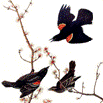Wildlife Damage Management, Internet Center for
Document Type
Article
Date of this Version
September 1970
Abstract
In 1966, when the annual damage survey was initiated, Dr. C. R. Weaver, Statistician at the Ohio Agriculture Research and Development Center, Wooster, Ohio, drew up a sampling plan, balancing costs against desired precision. The plan included three combinations of fields to be sampled and stations per field for high damage areas, three combinations for moderate damage areas, and two combinations for light damage areas. Alternatives for the high damage area included (1) 497 fields with two stations per field (± .48), (2) 775 fields with two stations per field (± .26), and (3) 235 fields with ten stations per field (— .68). For the moderate damage areas, the alternatives were (1) 441 fields with three stations per field (± .26), (2) 155 fields with three stations per field (± .50), and (3) 235 fields with ten stations per field (± .32). The light dam¬age area alternatives were (1) 297 fields with three stations per field (- .26), and (2) 81 fields with three stations per field (± .50). The original survey in 1966 sampled eight counties in three regions. In 1967, 14 counties in the same three regions were sampled. Two new counties were added to one region and two new regions with two counties each (treated as one region for sampling purposes) were added to the 1968 survey. The 1968 survey was of sufficient size to be representative of the corn damage picture in Ohio and Southeast Michigan. The 1969 survey was identical to the 1968 survey.

